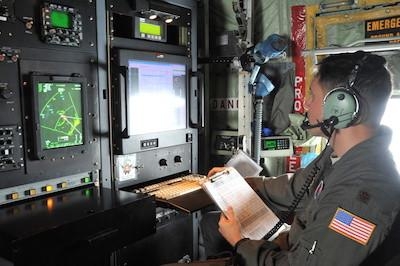Flew More Than 655 Hours And 83 Missions Into 12 Named Storms
The 2018 hurricane season, which ended Nov. 30, was an active one for the Air Force Reserve Hurricane Hunters, who flew more than 655 hours and 83 missions into 12 named storms over the Atlantic and Pacific oceans.

The 53rd Weather Reconnaissance Squadron, assigned to the Air Force Reserve’s 403rd Wing at Keesler Air Force, Mississippi, is the only Department of Defense unit that conducts aircraft reconnaissance missions into severe tropical weather during the hurricane season June 1 through Nov. 30.
These missions are flown to gather data for the National Hurricane Center to improve their forecasts and storm warnings.
“It was a very challenging season due to the Atlantic and Pacific basins being so active, stretching 53rd WRS capabilities across their area of responsibility,” said Maj. Jon Brady, 53rd WRS aerial reconnaissance weather officer. “In September alone, we evacuated aircraft from Keesler to Ellington Field, Texas, as Tropical Storm Gordon made its way toward the Gulf Coast. The squadron was operating out of Ellington for the final missions into Gordon. At the same time, the squadron was also preparing to deploy to Hawaii for both Hurricanes Norman and Olivia. While the squadron never flew Norman, due to its course veering to the north of Hawaii, they did perform reconnaissance operations for Hurricane Olivia four days later, which caused wind and flood damage to Maui and Oahu. On top of all that, the squadron was also preparing for Hurricane Florence, which was flown out of Savannah, Georgia.”
The 53rd WRS's operations area is immense, ranging from the mid-Atlantic to just west of Hawaii. Through an interagency agreement, tropical weather reconnaissance is governed by the National Hurricane Operations Plan, which requires the squadron to support 24-hour-a-day continuous operations, with the ability to fly up to three storms simultaneously with response times of 16 hours. To provide this quick reaction aircrew and aircraft maintenance force, the squadron has 10 full-time Reserve aircrews and 10 traditional Reserve part-time crews available to fly the 10 WC-130J Hercules aircraft designated to accomplish the mission.
The number of named storms exceeded the National Oceanic and Atmospheric Administration's prediction of 13 for the 2018 Atlantic hurricane season. There were 15 named storms—eight hurricanes of which two were major hurricanes, meaning they were a Category 3, 4 or 5 storm and six tropical storms.
The squadron kicked off the Atlantic season flying into Tropical Storm Alberto, which formed May 25 and made landfall in northern Florida. The unit also flew Beryl, Chris, Gordon, Kirk and the season’s most destructive storms Hurricanes Florence and Michael, which caused significant damage to the southeastern United States.
The first major hurricane of the season was Hurricane Florence. At its peak, it was a Category 4 hurricane but weakened to a Category 1 when it made landfall in North Carolina Sept. 14, bringing catastrophic flooding to the area. A month later, Hurricane Michael rapidly intensified into a Category 4 storm and made landfall Oct. 10 along the Florida Panhandle causing extensive damage to the Panama City including Tyndall Air Force Base, Florida. Winds speeds up to 155 mph, 1 mph short of Category 5 status, were documented with Hurricane Michael. The Hurricane Hunters were inside the storm center as it made landfall. Michael was the fourth-strongest storm to hit the continental United States, according to NOAA. Florence and Michael caused billions of dollars in damages and there were over 50 fatalities from Florence and 40 more from Michael.
While this year’s Atlantic hurricane season wasn’t as active as 2017, the hurricane season in the eastern Pacific Ocean was one of the most active season’s recorded, according to Colorado State University’s Tropical Meteorologist Phil Klotzbach. There were 22 named storms, 12 of which became hurricanes and nine of those were major hurricanes.
According to NHC, in terms of Accumulated Cyclone Energy, which measures the strength and duration of tropical storms and hurricanes, activity in the basin in 2018 was the third highest on record, behind 1990 and 1992.
The 53rd WRS deployed to Hawaii three times to fly Hurricanes Hector, Lane and Olivia. They also flew Hurricanes Rosa and Willa in the eastern Pacific, both of which made landfall in Mexico.
While the 2018 hurricane season has ended, the mission of the 53rd WRS has not. From Nov. 1 to March 31, the squadron flies winter storms off the East and West Coast of the U.S. and in the Gulf of Mexico. They will also conduct atmospheric river reconnaissance missions in early 2019, to collect data to determine atmospheric moisture content that pushes into the West Coast of the U.S. each winter season, which assists flooding forecasts. In between flying winter storms, atmospheric river missions, and training missions, the squadron will be preparing for the 2019 hurricane season, calibrating their weather instruments to ensure they are ready for Mother Nature’s next meteorological show of force.
(Image provided with USAF news release. Maj. Jeremy DeHart, a 53rd Weather Reconnaissance Squadron aerial reconnaissance weather officer, reviews data from hurricane Michael)
 Classic Aero-TV: The Switchblade Flying Car FLIES!
Classic Aero-TV: The Switchblade Flying Car FLIES! ANN FAQ: Q&A 101
ANN FAQ: Q&A 101 ANN's Daily Aero-Term (04.12.24): Discrete Code
ANN's Daily Aero-Term (04.12.24): Discrete Code ANN's Daily Aero-Term (04.13.24): Beyond Visual Line Of Sight (BVLOS)
ANN's Daily Aero-Term (04.13.24): Beyond Visual Line Of Sight (BVLOS) ANN's Daily Aero-Linx (04.13.24)
ANN's Daily Aero-Linx (04.13.24)



